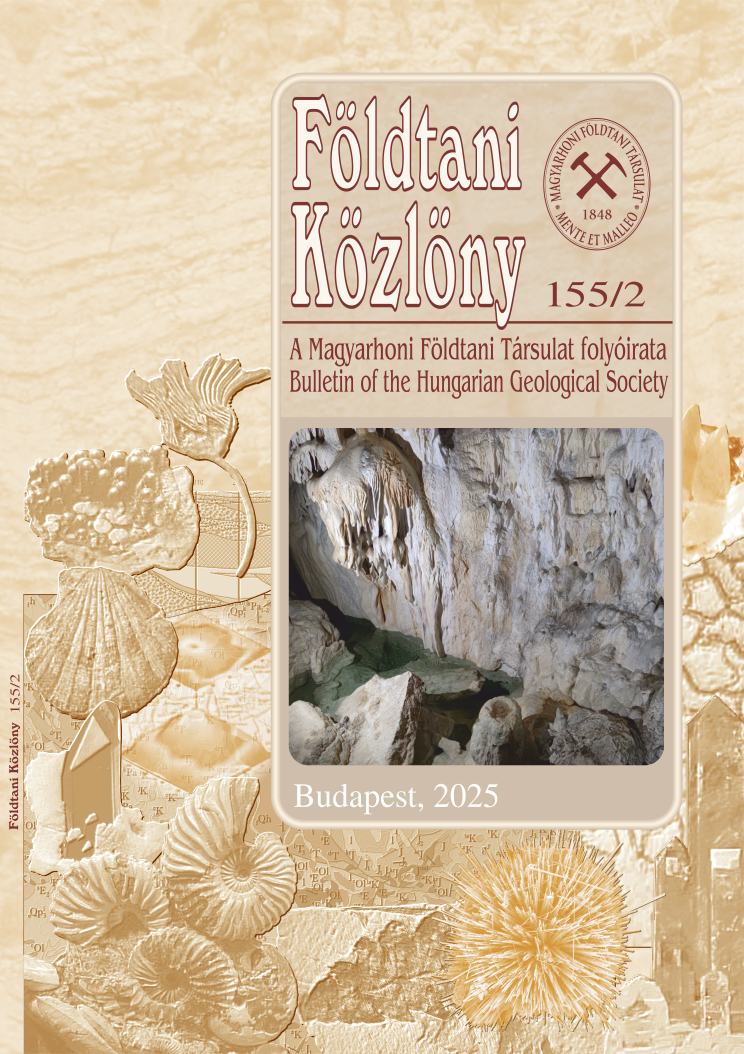New results on the bentonite exploration in Garancs Hill, Pilisvörösvár (Hungary)
Abstract
The study area is located at the SE slope of the Garancs Hill (289 m), NE from Pilisvörösvár, near the Pilisvörösvár–Csobánka road. The Fót Formation (Carpathian) occurs in the western part of the study area. The intercalated tuff layers are probably of Badenian age in the eastern part of the hill. The bentonite strata have thickness of 8–11 m. They were derived from the hydrodiagenetic alteration of dacitic tuffs according to the stratigraphical and mineralogical compositions, and total silica vs. alkali content.
The smectite content of the bentonite samples ranges between 47–49 wt%. The other mineralogical components of the samples are micas (illite/muscovite 9–14 wt %), quartz (20–28 wt%) and feldspars (7–15 wt%). These bentonites are characterized by subordinated kaolinite, cristobalite, goethite and amorphous phase. In this region the bentonite was mined for a short time before 1954.
The predominant exchangeable cation is Ca2+: Na+ (0.0295–0.0330), K+ (0.0185–0.0239), Ca2+ (0.2367–0.2518), Mg2+ (0.0986–0.1365) (cmol/kg). The swelling capacity ranges from 2.0 to 2.5 (natural) and from 5.0 to 15.0 (activated, 5% Na2CO3, ml/2g).
References
CARLSON, L. 2004: Bentonite mineralogy. Part 1. Methods of investigation — a literature review & Part 2. Mineralogical research of selected bentonites. —Posiva Oy, Olkiluoto. Working Report, 108 p.
FRITS J. 1949: Adatok a magyar bentonitkérdéshez a Komlóskai (Tokaj-Hegyalja) előfordulással kapcsolatban. — Kézirat, Magyar Állami Földtani, Geofizikai és Bányászati Adattár, 20 p. (Bn. 34)
FRITS J. 1951: Bentonit-fullerföld előfordulások készletei 1950. évi adatok alapján. — Kézirat, Magyar Állami Földtani, Geofizikai és Bányászati Adattár, Budapest, 6 p. (T: 4579)
GATES, W. P. 2005: Infrared spectroscopy and the chemistry of dioctahedral smectites. — In: KLOPROGGE J. T. (ed.): The Application of Vibrational Spectroscopy to Clay Minerals and Layered Double Hydroxides, Clay Minerals Soc., Aurora, CO, pp. 125–168.
GYALOG L. (szerk.) 2005: Magyarázó Magyarország fedett földtani térképéhez. — Magyar Állami Földtani Intézet Térképmagyarázói, 188 p.
GYALOG L. 2013: Magyarország földtani térképe, 1:500 000. — A Magyar Földtani és Geofizikai Intézet kiadványa.
GYALOG L. & SÍKHEGYI F. 2005: Magyarország földtani térképe, M=1:100 000. — CD. A Magyar Földtani Intézet Kiadványa, 88 szelvény.
HORUSITZKY F. 1950: Jelentés Magyarország bentonit készletéről. — Kézirat, Magyar Állami Földtani, Geofizikai és Bányászati Adattár, Budapest, 13 p. (Bn. 41)
KÁDÁR L.-NÉ 1982: Új bentonitféleségek kutatása, II. — Kézirat, Kutatási jelentés, Központi Bányászati Fejlesztési Intézet,
Magyar Állami Földtani, Geofizikai és Bányászati Adattár, 93 p. (T:12979)
KLUG, H. P. & ALEXANDER, L. E. 1954: X-ray diffraction procedures for polycrystalline and amorphous materials. — Wiley, New York, 716 p.
REICH L. 1951: Jelentés a mészkő-, bentonit-, ásványi festékanyag-, cement-, márga- és vízkészlet nyilvántartási táblázat-minták összeállításáról. — Kézirat, Magyar Állami Földtani, Geofizikai és Bányászati Adattár, Budapest, 4 p. (Ált. 19/a)
SCHAFARZIK F., VENDL A. & PAPP F. 1964: Geológiai kirándulások Budapest környékén. — Műszaki Könyvkiadó, Budapest, 296 p.
SOLTI G. 1983: A kemenesháti bentonit prognózis javaslat (prognózis). — Kézirat, Magyar Állami Földtani, Geofizikai és Bányászati Adattár, Budapest, 184 p. (T:12332)
SZALAI T. 1949: Hazai fullerföld-bentonit előfordulások. — Kézirat, Magyar Állami Földtani, Geofizikai és Bányászati Adattár, Budapest, 3 p. (Bn. 36)
VADÁSZ E. 1960: Magyarország földtana. — Akadémiai Kiadó, Budapest, 646 p.
VARJÚGY. 1953: A magyar bentonit jelenlegi helyzete. — Kézirat, Magyar Állami Földtani, Geofizikai és Bányászati Adattár, Budapest, 14 p. (Bn. 53)
VARJÚ GY. 1954: Pilisvörösvári bentonitterület tájékoztató kutatásának összefoglaló jelentése. — Kézirat, Magyar Állami Földtani, Geofizikai és Bányászati Adattár, Budapest, 9 p. (Bn. 55)
VARJÚ GY. 1955: Pilisvörösvári bentonitterület tájékoztató kutatásának összefoglaló jelentése. — Kézirat, Magyar Állami Földtani, Geofizikai és Bányászati Adattár, Budapest, 10 p. (Bn. 59)
VARJÚ GY. 1964–1966: Magyarország bentonit előfordulásainak katasztere és távlati kutatási terve. — Kézirat, Magyar Állami Földtani, Geofizikai és Bányászati Adattár, Budapest, 102 p. (T:1820)
ZELENKA T. 1960: Kőzettani és földtani vizsgálatok a Dunazug-hegység DNy-i részén. — Földtani Közlöny 90/1, 83–102.











